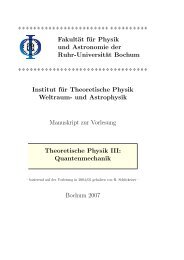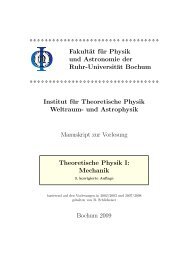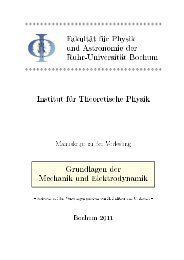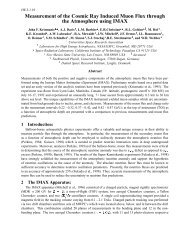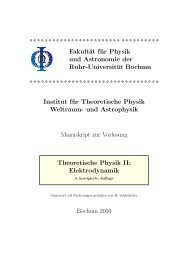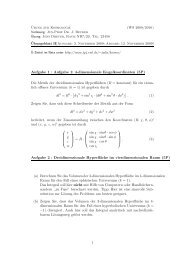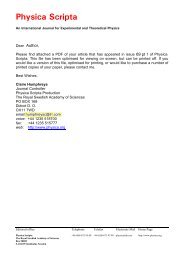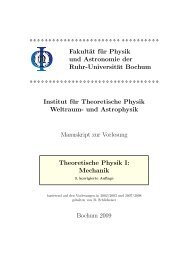Heating of the ISM by Alfvén-wave damping - Theoretische Physik IV ...
Heating of the ISM by Alfvén-wave damping - Theoretische Physik IV ...
Heating of the ISM by Alfvén-wave damping - Theoretische Physik IV ...
Create successful ePaper yourself
Turn your PDF publications into a flip-book with our unique Google optimized e-Paper software.
”The Magnetized Interstellar Medium”<br />
8–12 September 2003, Antalya, Turkey<br />
Eds.: B. Uyanıker, W. Reich & R. Wielebinski<br />
<strong>Heating</strong> <strong>of</strong> <strong>the</strong> <strong>ISM</strong> <strong>by</strong> Alfvén-<strong>wave</strong> <strong>damping</strong><br />
Felix Spanier<br />
Institut für <strong>Theoretische</strong> <strong>Physik</strong> <strong>IV</strong>, Ruhr-Universität Bochum, Universitätsstr. 150, 44801 Bochum<br />
Abstract. We calculate <strong>the</strong> heating rate from <strong>damping</strong> <strong>of</strong> Alfvén <strong>wave</strong>s in <strong>the</strong> warm ionized medium. An anisotropic<br />
<strong>wave</strong> spectrum was used and <strong>the</strong> <strong>damping</strong> processes considered were collision Landau <strong>damping</strong>, Joule heating, viscous<br />
<strong>damping</strong> and ion-neutral collisions.<br />
1 <strong>ISM</strong> scenario<br />
We consider a scenario found in <strong>the</strong> Warm Intercloud Medium with <strong>the</strong> following parameters:<br />
temperature T ≈ 10 4 K, particle density n ≈ 0.2 cm −3 and a background magnetic field B = 4 µG.<br />
Therefore we find an efficient cooling mechanism with <strong>the</strong> cooling rate<br />
L R = 5 · 10 −24 n 2 e erg s −1 cm −3 (1)<br />
as proposed <strong>by</strong> Minter & Spangler (1997).<br />
One finds a mixture <strong>of</strong> Alfvén and fast magnetosonic <strong>wave</strong>s, we will focus on Alfvén Waves. As<br />
Spangler (1991) points out that <strong>the</strong>se <strong>wave</strong>s must <strong>wave</strong> numbers in <strong>the</strong> regime<br />
k min =<br />
2π<br />
10 17 cm , k max = 2π<br />
10 7 cm<br />
which is given <strong>by</strong> <strong>the</strong> ion inertia length on <strong>the</strong> one hand and on <strong>the</strong> distance between two clouds on<br />
<strong>the</strong> o<strong>the</strong>r hand.<br />
2 Wave spectrum<br />
We use an anisotropic power spectrum <strong>of</strong> electron density fluctuations from Spangler (1991)<br />
P nn =<br />
CN<br />
2<br />
(k‖ 2 + Λk2 ⊥ ) 2+s<br />
2<br />
(2)<br />
To derive <strong>the</strong> magnetic fluctuation spectra a kinetic approach is needed (Schlickeiser & Lerche 2002)<br />
P A yy( ⃗ k)<br />
B 2 0<br />
= Ω2 p sin 2 θ<br />
9V 2 A k2 P A nn( ⃗ k)<br />
n 2 e<br />
whereas for fast magnetosonic <strong>wave</strong>s <strong>the</strong> relation between both spectra is nearly linear.<br />
The constant C N is defined <strong>by</strong> normalisation over <strong>the</strong> total fluctuating power<br />
∫<br />
d 3 k P nn ( ⃗ k) = (δn e ) 2 (4)<br />
As <strong>the</strong> power is splitted into two parts for magnetosonic and Alfvén <strong>wave</strong>s, we introduce two constants,<br />
C A and C M which determine <strong>the</strong> magnetic fluctuations.<br />
∫<br />
(δB A ) 2 = d 3 kPyy( A ⃗ k)<br />
(3)<br />
(5)<br />
1
2 Felix Spanier<br />
3 Damping Processes<br />
For a given <strong>damping</strong> rate <strong>the</strong> energy dissipation rate is given <strong>by</strong>:<br />
∫<br />
ɛ i = d 3 kPyy2γ A i (6)<br />
Four different processes have been included in<br />
<strong>the</strong> calculation:<br />
• Collisionless Landau <strong>damping</strong><br />
• Viscous <strong>damping</strong><br />
• Joule heating<br />
• Ion-Neutral collisions<br />
3.1 Joule <strong>Heating</strong><br />
Joule heating is related to <strong>the</strong> resistivity <strong>of</strong> <strong>the</strong><br />
plasma and <strong>the</strong> currents. We take <strong>the</strong> formula<br />
from Braginskii (1965)<br />
Fig. 1. Damping rates at θ = 2 ◦<br />
resulting in<br />
σ ⊥ = ω2 pe<br />
4πν e<br />
, σ ‖ = 1.96σ ⊥ (7)<br />
γ J (k) = ν ec 2 k 2<br />
2ω 2 pe<br />
(<br />
cos 2 θ + 0.51 sin 2 θ ) (8)<br />
Joule heating is neglected in favor <strong>of</strong> viscosity.<br />
3.2 Viscosity<br />
Viscosity was proposed <strong>by</strong> Hollweg (1985), <strong>the</strong> parameter η 0 cancels out due to <strong>the</strong> incompressibility<br />
<strong>of</strong> Alfvén <strong>wave</strong>s<br />
γ V (k) =<br />
k2 (<br />
(η<br />
p<br />
1<br />
2m p n + ηe 1) sin 2 θ + (η p 2 + ηe 2) cos 2 θ ) (9)<br />
e<br />
The electron contribution is small compared to <strong>the</strong> proton contribution<br />
Introducing<br />
γ V (k) ≃ 0.15 k BT p k 2 c 2 τ i<br />
(<br />
sin 2<br />
m p c 2 (Ω p τ i ) 2 θ + 4 cos 2 θ ) (10)<br />
k c = Ω p<br />
V A<br />
, κ = k k c<br />
we find for Joule and viscous <strong>damping</strong> toge<strong>the</strong>r<br />
γ V +J = 10 −7 κ 2 ( sin 2 θ + 4 cos 2 θ ) (11)<br />
As Joule and viscous <strong>damping</strong> have <strong>the</strong> same k 2 dependence and similar angular depence we may sum<br />
<strong>the</strong>m up. Integrating with 6 gives<br />
ɛ V +J = 4 · 10 7 1 + s<br />
3 − s (δB κ 3−s<br />
A) 2 kc<br />
2 max − κ 3−s<br />
min<br />
κ 1+s<br />
max − κ 1+s H V +J (Λ, s) (12)<br />
min<br />
H V +J (Λ, s) = 3F ( 2+s<br />
2+s<br />
2<br />
, 1; 3; 1 − Λ−1)<br />
8F ( 3F (<br />
2<br />
2+s<br />
2 , 1 2 ; 5 + , 2; 4; 1 − Λ−1 )<br />
2<br />
; 1 − Λ−1) 8F ( 2+s<br />
2 , 1 2 ; 5 2 ; 1 − (13)<br />
Λ−1 )
<strong>Heating</strong> <strong>of</strong> <strong>the</strong> <strong>ISM</strong> <strong>by</strong> Alfvén-<strong>wave</strong> <strong>damping</strong> 3<br />
resulting in<br />
ɛ V +J = 10 −39 erg s −1 cm −3 (Λ = 1) (14)<br />
This gives only a small contribution, so it has no influence on <strong>ISM</strong> heating.<br />
3.3 Collisionless Landau<br />
We are using <strong>the</strong> <strong>damping</strong> rate for obliquely propagating shear Alfvén <strong>wave</strong>s (Ginzburg 1961, p.218,<br />
Eq. (14.56))<br />
γ L =<br />
≃<br />
Inserting into Eq. (6) yields<br />
( π<br />
) 1/2 ω<br />
3<br />
v e tan 2 θ<br />
8 Ω 2 p V A sin 2 θ + 3(ω 2 /Ω 2 p) cos 2 θ<br />
× ( vi 2 /ve 2 + (sin 2 θ + 4 cos 2 θ) exp[−VA/(2v 2 i 2 cos 2 θ)] )<br />
( π<br />
) 1<br />
2 m e<br />
v e k c κ 3 cos θ + sin 2 θ<br />
8 m p sin 2 θ + 3κ 2 cos 4 θ<br />
(15)<br />
Approximations<br />
ɛ L = 1.1 · 10 −5 1 + s<br />
2 − s v ek c (δB A ) 2 κ2−s max − κ 2−s<br />
min<br />
κ 1+s<br />
max − κ 1+s H L (Λ, s) (16)<br />
min<br />
H L (Λ, s) = 3F ( 2+s<br />
2<br />
, 1; 3; 1 − Λ−1)<br />
8F ( 2+s<br />
2 , 1 2 ; 5 (17)<br />
2<br />
; 1 − Λ−1)<br />
H L (Λ ≫ 1) ≃ const (18)<br />
H L (Λ ≪ 1) ∝ Λ 1/2 (19)<br />
For given <strong>ISM</strong> parameters we find<br />
ɛ L ≃ 3.8 · 10 −42 erg s −1 cm −3 (Λ = 1) (20)<br />
Collisionless Landau <strong>damping</strong> can be ignored for any value <strong>of</strong> Λ.<br />
Comparison to Fast Magnetosonic <strong>wave</strong>s<br />
Lerche & Schlickeiser (2001):<br />
3.4 Ion-Neutral<br />
R(Λ = 1) = ɛA L (Λ = 1)<br />
ɛ M L (Λ = 1) ≃ (δB A) 2<br />
10−20<br />
(δB M ) 2 (21)<br />
R(Λ ≫ 1) ≃ 10 −20 Λ s/2 (δB A) 2<br />
R(Λ ≪ 1) ≃ 10 −20 Λ −s/2 (δB A) 2<br />
(δB M ) 2 (22)<br />
(δB M ) 2 (23)<br />
γ N (k) ≃ ν N cos 2 θ , κ ≥ κ N cos θ (24)<br />
ν N = 4 · 10 −9 n H Hz (25)<br />
κ N = ν N [Hz]<br />
(26)<br />
B[G]
4 Felix Spanier<br />
γ N holds for propagation angles | θ |≤ π 2 − ω R/43Ω p<br />
Integrating considering <strong>the</strong> critical <strong>wave</strong> number<br />
ɛ N =<br />
We have two approximations for H N :<br />
2<br />
π(2 − s)(4 − s) ν Nt s+1<br />
2<br />
E (δB A) 2 H N (Λ, s) (27)<br />
H N (Λ, s) =<br />
2+s<br />
3F (<br />
2 , 2; 3 − s 2 ; 1 − Λ)<br />
4F ( 2+s<br />
2 , 1 2 ; 5 2 ; 1 − Λ) (28)<br />
ɛ N = 1.74 · 10 −29 erg s −1 cm −3 (29)<br />
H N (Λ ≫ 1) ≃ 2 s−3 (4 − s)(2 − s) (30)<br />
H N (t E < Λ ≪ 1) ≃<br />
s + 1<br />
(4 − s)(2 − s) 2 Λ−s/2 (31)<br />
This is <strong>the</strong> most important process, though <strong>the</strong> heating rate is still too small to maintain <strong>the</strong><br />
temperature balance.<br />
4 Conclusion<br />
• Ion-Neutral Damping is <strong>the</strong> dominant <strong>damping</strong> process in Alfvén <strong>wave</strong>s<br />
• Anisotropy can reduce <strong>damping</strong> for perpendicular <strong>wave</strong>s<br />
• Alfvén <strong>wave</strong>s cannot contribute significantly to <strong>the</strong> temperature balance <strong>of</strong> <strong>the</strong> <strong>ISM</strong><br />
Fig. 2. Energy dissipation rate vs. anisotropy parameter Λ<br />
References<br />
Braginskii, S. I., 1965, Rev. Plasma Phys. 1, 205<br />
Ginzburg, V. I., 1961, Propagation <strong>of</strong> Electromagnetic Waves in Plasma, Pergamon Press, New York<br />
Hollweg, J. V., 1985, J. Geophys. Res. 90, 7620<br />
Kulsrud, R. M., & Pearce, W. P., 1969, ApJ 156, 445<br />
Lerche, I., & Schlickeiser, R., 1982, MNRAS 201, 1041<br />
Lerche, I., & Schlickeiser, R., 2001, A& A 366, 1008 (paper I)<br />
Lerche, I., & Schlickeiser, R., 2002, A& A 383, 319<br />
Minter, A. H., & Spangler, S. R., 1997, ApJ 485, 182<br />
Schlickeiser, R., & Lerche, I., 2002, J. Plasma Phys. 68, 191<br />
Spangler, S. R., 1991, ApJ 376, 540



